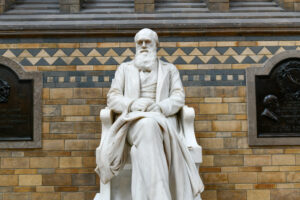Posted by Roberta Grimes • June 29, 2024 • 4 Comments
Human Nature, Understanding Reality
All things bright and beautiful, all creatures great and small,
All things wise and wonderful, ‘Twas God that made them all.
Each little flower that opens, each little bird that sings.
He made their glowing colors, and made their tiny wings.
The purple-headed mountains, the rivers running by.
The sunset, and the morning that brightens up the sky.
The cold wind in the winter, the pleasant summer sun,
The ripe fruits in the garden, He made them, every one.
All things bright and beautiful, all creatures great and small,
All things wise and wonderful, ’twas God that made them all.
He gave us eyes to see them, and lips that we might tell
How great is the Almighty, who has made all things well.
– Cecil F. Alexander (1818-1895), from “All Things Bright and Beautiful” (1848)
 As I was still thinking about my previous blog post last Sunday morning, I chanced to spot the latest issue of Scientific American lying on our front-hall table. Not so long ago, those popular science magazine covers would trumpet enticing articles about major breakthroughs in important fields like the origin of matter, the origin of life, the secret life of cells, genetics technology, or perhaps about this or that other wonderful materialist scientific triumph soon to be made by the glorious heroes of modern science! And their cover illustrations were brightly varicolored interiors of cells, or diagrams of DNA and RNA in action, or else they might be intensely varicolored shots of interstellar space. Even maybe fifteen years ago, the fun of what it surely was to be a well-employed research science would be dancing laughingly right off the paper of every one of those magazine covers.
As I was still thinking about my previous blog post last Sunday morning, I chanced to spot the latest issue of Scientific American lying on our front-hall table. Not so long ago, those popular science magazine covers would trumpet enticing articles about major breakthroughs in important fields like the origin of matter, the origin of life, the secret life of cells, genetics technology, or perhaps about this or that other wonderful materialist scientific triumph soon to be made by the glorious heroes of modern science! And their cover illustrations were brightly varicolored interiors of cells, or diagrams of DNA and RNA in action, or else they might be intensely varicolored shots of interstellar space. Even maybe fifteen years ago, the fun of what it surely was to be a well-employed research science would be dancing laughingly right off the paper of every one of those magazine covers.
And what is the title of this latest issue of Scientific American’s breakthrough cover article? It is The New Science of Health and Appetite: What humans really evolved to eat and how food affects our health today. I kid you not! And the cover picture is a drawing of a burnt-orange hand holding a burnt-orange fork which carries an unappetizing sketch of burnt-orange food. All of this is displayed on a pale-yellow background. To my mind, it looks so unappealing that you might as well either read that promised article, or else you could just sit and watch paint dry.
 What I have been trying to understand of late is why the thought of intelligent design still so deeply horrifies mainstream scientists. When I was a child, I was so eager to confirm that my childhood experiences of light must of course be confirmation that there is a God behind it all that the first thing I did right out of college was to spend two years deep in researching life after death, until I had convinced myself that the afterlife is real, and therefore that God must be real. You would think that discovering that intelligence (or consciousness) is a necessary component of life, which clearly it is, would seem like good news to scientists?
What I have been trying to understand of late is why the thought of intelligent design still so deeply horrifies mainstream scientists. When I was a child, I was so eager to confirm that my childhood experiences of light must of course be confirmation that there is a God behind it all that the first thing I did right out of college was to spend two years deep in researching life after death, until I had convinced myself that the afterlife is real, and therefore that God must be real. You would think that discovering that intelligence (or consciousness) is a necessary component of life, which clearly it is, would seem like good news to scientists?
This split between studying material reality and studying non-material reality actually began more than two thousand years ago as a gentleman’s dispute between Plato and Aristotle. And of course, the split actually made no sense even then. It should seem obvious to anyone who feels a physical need to breathe that just because something lacks mass, size, color, and weight and it cannot be perceived by the naked eye, we cannot assume that it is not important! So it should have been obvious to the breathing scientists who, at the turn of the twentieth century, decided that they were going to turn mainstream science into the study of matter alone that this self-imposed ban on studying what is not material was self-evidently flat-out stupid. But those scientists do deserve a modicum of our pity. The poor souls were still reeling from the advent of quantum mechanics.
 It is difficult for those of us who are not physicists to comprehend just what a clout to the head quantum physics was for Newtonian physicists at the turn of the twentieth century. One notable physicist whose name escapes me actually had said at the end of the nineteenth century that just about everything had been discovered in physics by whatever date that was, and all that was left to be done was finer and finer measurements. And then along came quantum physics, and the whole science of physics was altogether upended. By 1918, Max Planck was being awarded the 1918 Nobel Prize in physics as the father of quantum mechanics; and as he delved into it further, he came to ever more fully understand that what you and I experience as consciousness was a new and wondrous element to be investigated, in and of itself. In 1931, Dr. Planck said, “I regard consciousness as fundamental. I regard matter as derivative from consciousness. We cannot get behind consciousness! Everything that we talk about, everything that we regard as existing, postulates consciousness.” And in 1944 he said, “As a man who has devoted his whole life to the most clear-headed science, to the study of matter, I can tell you as a result of my research about atoms this much: There is no matter as such. All matter originates and exists only by virtue of a force which brings the particle of an atom to vibration and holds this most minute solar system of the atom together. We must assume behind this force the existence of a conscious and intelligent mind. This mind is the matrix of all matter.”
It is difficult for those of us who are not physicists to comprehend just what a clout to the head quantum physics was for Newtonian physicists at the turn of the twentieth century. One notable physicist whose name escapes me actually had said at the end of the nineteenth century that just about everything had been discovered in physics by whatever date that was, and all that was left to be done was finer and finer measurements. And then along came quantum physics, and the whole science of physics was altogether upended. By 1918, Max Planck was being awarded the 1918 Nobel Prize in physics as the father of quantum mechanics; and as he delved into it further, he came to ever more fully understand that what you and I experience as consciousness was a new and wondrous element to be investigated, in and of itself. In 1931, Dr. Planck said, “I regard consciousness as fundamental. I regard matter as derivative from consciousness. We cannot get behind consciousness! Everything that we talk about, everything that we regard as existing, postulates consciousness.” And in 1944 he said, “As a man who has devoted his whole life to the most clear-headed science, to the study of matter, I can tell you as a result of my research about atoms this much: There is no matter as such. All matter originates and exists only by virtue of a force which brings the particle of an atom to vibration and holds this most minute solar system of the atom together. We must assume behind this force the existence of a conscious and intelligent mind. This mind is the matrix of all matter.”
Max Planck had discovered the genuine Creator not by positing a God, but rather by coming at that creator from the position of the created particle. And the scientific gatekeepers flat could not have that! It was this whole flirting with invisibles that the gatekeepers simply could not abide, because Planck’s doing that brought the discipline of science too near to the woo-woo notion of an invisible God. But humankind has long assumed that God was some sort of pre-existent, separate Person anyway, a kind of invisible Big Guy in the Sky. And if God was an entity separate from God’s material creation, then it was reasonable, and indeed it was even necessary, to assume that this material creation could be studied separately from its Creator. Well, fair enough. But then the next step of course was for those who were studying this separate created reality to decide that reality could easily be studied without any reference to a Creator at all. So as our culture had evolved past the Middle Ages, so had the increasingly modern scientific theory that all of this matter around us can easily have arisen and evolved entirely randomly. Therefore, long before Max Plank discovered the genuine God in the twentieth century, indeed back as far as that intellectual rivalry between Plato and Aristotle, some people had begun to assume that you could study material reality without making reference to where it may have come from. So Max Planck’s fellow scientists thought there was no point to his even bringing God’s Mind up now!
that creator from the position of the created particle. And the scientific gatekeepers flat could not have that! It was this whole flirting with invisibles that the gatekeepers simply could not abide, because Planck’s doing that brought the discipline of science too near to the woo-woo notion of an invisible God. But humankind has long assumed that God was some sort of pre-existent, separate Person anyway, a kind of invisible Big Guy in the Sky. And if God was an entity separate from God’s material creation, then it was reasonable, and indeed it was even necessary, to assume that this material creation could be studied separately from its Creator. Well, fair enough. But then the next step of course was for those who were studying this separate created reality to decide that reality could easily be studied without any reference to a Creator at all. So as our culture had evolved past the Middle Ages, so had the increasingly modern scientific theory that all of this matter around us can easily have arisen and evolved entirely randomly. Therefore, long before Max Plank discovered the genuine God in the twentieth century, indeed back as far as that intellectual rivalry between Plato and Aristotle, some people had begun to assume that you could study material reality without making reference to where it may have come from. So Max Planck’s fellow scientists thought there was no point to his even bringing God’s Mind up now!
 There probably is a long and complex history to Darwinian theory that I should have studied more closely. I do recall that there were some competing theories of evolution in the nineteenth century, and I was caught up in reading about those for a time in the nineteen-seventies. I thought as a result of my studies that mainstream science’s complete embrace of Charles Darwin (1809-1882) and his theory of evolution had been too hasty and simplistic, when Jean-Baptiste Lamarck (1744-1829), for example, had championed the useful evolutionary refinement that some characteristics or tendencies may be acquired during the life of an animal and passed down to that animal’s descendants, which would make evolution more efficient and also likely more rapid. And I think that an objective study of the evidence proves that Lamarck was at least partly right. But it seems to have been during the nineteenth century that mainstream science as a whole formalized itself into this anti-divine-intelligence, and just-matter-alone sort of very dry discipline. And it seems even to have been the discovery that evolution does actually in fact happen that made the scientific gatekeepers first come to decide that their new materialist dogma would be enforceable against naturally obstreperous and free-thinking scientists.
There probably is a long and complex history to Darwinian theory that I should have studied more closely. I do recall that there were some competing theories of evolution in the nineteenth century, and I was caught up in reading about those for a time in the nineteen-seventies. I thought as a result of my studies that mainstream science’s complete embrace of Charles Darwin (1809-1882) and his theory of evolution had been too hasty and simplistic, when Jean-Baptiste Lamarck (1744-1829), for example, had championed the useful evolutionary refinement that some characteristics or tendencies may be acquired during the life of an animal and passed down to that animal’s descendants, which would make evolution more efficient and also likely more rapid. And I think that an objective study of the evidence proves that Lamarck was at least partly right. But it seems to have been during the nineteenth century that mainstream science as a whole formalized itself into this anti-divine-intelligence, and just-matter-alone sort of very dry discipline. And it seems even to have been the discovery that evolution does actually in fact happen that made the scientific gatekeepers first come to decide that their new materialist dogma would be enforceable against naturally obstreperous and free-thinking scientists.
 And so, very early in the twentieth century, the scientific gatekeepers forcibly shut mainstream science down as a system where scientific research which included any element of intelligent design at all was ever allowed to be included in any research product that was being taught in any university department or published in any peer-reviewed article to be included in any scientific journal. While quantum mechanics was still in its infancy, and Max Planck and the other early quantum physicists still were proving that non-local action and other weird quantum effects actually are perfectly real, those gatekeepers were imposing the new “fundamental scientific dogma of materialism” on all aspects of scientific research. Research scientists were no longer allowed to include intelligent design in any aspect of their study of any natural phenomenon whatsoever.
And so, very early in the twentieth century, the scientific gatekeepers forcibly shut mainstream science down as a system where scientific research which included any element of intelligent design at all was ever allowed to be included in any research product that was being taught in any university department or published in any peer-reviewed article to be included in any scientific journal. While quantum mechanics was still in its infancy, and Max Planck and the other early quantum physicists still were proving that non-local action and other weird quantum effects actually are perfectly real, those gatekeepers were imposing the new “fundamental scientific dogma of materialism” on all aspects of scientific research. Research scientists were no longer allowed to include intelligent design in any aspect of their study of any natural phenomenon whatsoever.
 This newly imposed and enforced scientific supposition, simply put, must be that all of reality randomly arose in an instant without any Creator at all, and from there reality must have evolved entirely by random happenstance. What first existed of this whole universe was an endless and timeless nothing. And then a “Big Bang” happened 13.7 billion years ago, and its product changed and evolved on its own to become all of this, including every star, planet, atom, green plant, dinosaur, mosquito, kitten, and you and me. All of it occurred with no Creator at all, and for no reason at all. It was entirely random. Which, on its face, seems to make no sense. Actually, after the word “random” in the prior sentence, I wanted simply to write, “So therefore after the Big Bang happened, that nothing from before the Bang expanded endlessly into eternity. The End.” But that is not what actually happened. Instead, we have in what was amazingly short order ended up in possession of this goldilocks planet which is ideally situated and fine-tuned for life; and here you and I live what are apparently highly purpose-driven lives, although that is a story for another day.
This newly imposed and enforced scientific supposition, simply put, must be that all of reality randomly arose in an instant without any Creator at all, and from there reality must have evolved entirely by random happenstance. What first existed of this whole universe was an endless and timeless nothing. And then a “Big Bang” happened 13.7 billion years ago, and its product changed and evolved on its own to become all of this, including every star, planet, atom, green plant, dinosaur, mosquito, kitten, and you and me. All of it occurred with no Creator at all, and for no reason at all. It was entirely random. Which, on its face, seems to make no sense. Actually, after the word “random” in the prior sentence, I wanted simply to write, “So therefore after the Big Bang happened, that nothing from before the Bang expanded endlessly into eternity. The End.” But that is not what actually happened. Instead, we have in what was amazingly short order ended up in possession of this goldilocks planet which is ideally situated and fine-tuned for life; and here you and I live what are apparently highly purpose-driven lives, although that is a story for another day.
 Just as an aside, what is Intelligent Design, anyway? If you Google the term, you will be dismissively told that it is “a pseudoscientific argument for the existence of God.” I haven’t linked you to the Wikipedia article, and I have changed the title of this blog post at the last minute as well, because the Wiki article, and the scientific community itself, are so insultingly dismissive of the term. But I have seen enough now to be certain that indeed the verdict is decisively in, and this universe cannot have arisen randomly. At least some aspects of the components of cells, and some elements of life, plus other things as well could never have evolved without the help of an intelligent designer, not even in a literal infinity of random chance attempts.
Just as an aside, what is Intelligent Design, anyway? If you Google the term, you will be dismissively told that it is “a pseudoscientific argument for the existence of God.” I haven’t linked you to the Wikipedia article, and I have changed the title of this blog post at the last minute as well, because the Wiki article, and the scientific community itself, are so insultingly dismissive of the term. But I have seen enough now to be certain that indeed the verdict is decisively in, and this universe cannot have arisen randomly. At least some aspects of the components of cells, and some elements of life, plus other things as well could never have evolved without the help of an intelligent designer, not even in a literal infinity of random chance attempts.
So it is not surprising that over the course of the otherwise scientifically highly productive twentieth century, research scientists gradually gave up on a lot of their mission of discovery as mostly hopeless. And there is no need here really even to document their manifold failures! While technology was doing wonders to ever better our lives, Darwinian evolution as a theory was being shot full of numberless holes. And scientific efforts to discover how matter, and then how life came into being all on their own were essentially found to be hopelessly unachievable.
 Then came the founding of The Discovery Institute in 1991. The research scientists there carry on as do research scientists everywhere, except that that they assume that a Christian God is behind it all, providing the spark of life, guiding evolution, and planning and shaping the design of those first cells. And they have solved many of the problems that mainstream scientists had brought upon themselves with their materialist dogma in pursuing the origin of matter and the origin of life, and so much more! This is one of The Discovery Institute’s very many cheery cartoons. This cartoon explains how positing an intelligent designer can solve the otherwise insoluble problems that arise when scientists attempt to address how our cells repair the daily damage being done to DNA. These cartoons are at once silly and entertaining, and yet they are surprisingly sophisticated.
Then came the founding of The Discovery Institute in 1991. The research scientists there carry on as do research scientists everywhere, except that that they assume that a Christian God is behind it all, providing the spark of life, guiding evolution, and planning and shaping the design of those first cells. And they have solved many of the problems that mainstream scientists had brought upon themselves with their materialist dogma in pursuing the origin of matter and the origin of life, and so much more! This is one of The Discovery Institute’s very many cheery cartoons. This cartoon explains how positing an intelligent designer can solve the otherwise insoluble problems that arise when scientists attempt to address how our cells repair the daily damage being done to DNA. These cartoons are at once silly and entertaining, and yet they are surprisingly sophisticated.
 Most recently, some of the best research scientists are coming to concede that intelligent design may actually be on the scientific cutting edge. First, because the political left’s wokeness has begun in some cases to put atheists on the same side of debates as the intelligent design crowd, as some entirely worthy materialist scientists are even losing their university positions now for not being sufficiently politically “woke”. And second, because in at least one case, an evolutionary biologist couple has felt forced to concede that an intelligent design research scientist is in fact on the scientific cutting edge. And in any event, as far as origin of life research is concerned, intelligent design researcher James Tour remains the undisputed king. Dr. Tour has managed to solve every origin-of-life problem, while the materialists in this field still are nowhere.
Most recently, some of the best research scientists are coming to concede that intelligent design may actually be on the scientific cutting edge. First, because the political left’s wokeness has begun in some cases to put atheists on the same side of debates as the intelligent design crowd, as some entirely worthy materialist scientists are even losing their university positions now for not being sufficiently politically “woke”. And second, because in at least one case, an evolutionary biologist couple has felt forced to concede that an intelligent design research scientist is in fact on the scientific cutting edge. And in any event, as far as origin of life research is concerned, intelligent design researcher James Tour remains the undisputed king. Dr. Tour has managed to solve every origin-of-life problem, while the materialists in this field still are nowhere.
My dear ones, I cannot begin to tell you how foolish this whole materialist scientific dispute looks to everyone who still retains even a modicum of common sense! As the great Nikola Tesla said, “The day science begins to study non-physical phenomena, it will make more progress in one decade than in all the previous centuries of its existence.”
All things bright and beautiful, all creatures great and small,
All things wise and wonderful, ’twas God that made them all.
He gave us eyes to see them, and lips that we might tell
How great is the Almighty, who has made all things well.
– Cecil F. Alexander (1818-1895), from “All Things Bright and Beautiful” (1848)
Dear Roberta,
Yes, Lamark was right. Good evidence was developed several years ago, and the evidence was sufficient to establish a new field of research which is termed epigenetics.
Scientific American was bought by some French company a couple of decades ago, and has morphed into a liberal rag that dotes on pap. Over the past few years I have tried to use the Letters to the Editor section to introduce ideas about the primacy of consciousness over matter, and also the published empirical research demonstrating that Einstein was right in his argument with Bohr, as elementary particles, which are hard to observe, do own a definite “existence” and not an imaginary statistical (quantum) spread; I cited my published research as backing, but SA not only will not print my letters, but does not even bother to acknowledge receipt of them.
Oh my very dear and much-beloved Jack, thank you so very much for this wonderful comment!! Fascinating information about Lamarck – I didn’t realize that he had ever been acknowledged at all, but I thought back in the seventies, when I knew precisely zero about this stuff, that what he had written made a lot of sense and should have been given more credence, rather than just being cast aside and ignored altogether in favor of Darwin’s far too simplistic and random theory. I know nothing about the argument between Einstein and Bohr – my goodness, you really do get around, my dear one! I wasn’t aware of SA’s sale, although I have indeed noticed that the magazine has become ever flakier in recent years. I guess we’ll be letting that one lapse 🙂
Dear Roberta,
The lab work on particles (e.g., electrons and photons) during Einstein’s early research years faced the problem that the energy required to observe them (say by creating a magnetic field that would fluctuate as a particle moved though it, or light that might be showered on a particle to observe where it was and also show its motion) was generally higher than the particle; the lab equipment was relatively clumsy. But Heisenberg working as Bohr’s student came to the conclusion that the fundamental problem in measuring any particle for its location and movement was that particles did not have a fixed, definite existence, but instead owned a statisticle distribution. The range of this theoretical distributuion was discovered by Plank, and is termed the Plank constant (Plank has defined the constant as a fudge factor to make an equation balence, but only later realized that it actually could be assigned a meaningful role. The Plank constant is incrfeadibly small. Bohr then theorized that, by the perspective of operationalism in physics (any entity maust be observable to earn its status as real), then because sub atomic particles, such as electrons, an also photons), if they could not be definitely measuired (for location and motion), they had to be regarded as hazy, with an indefinite reality status; such paticles were said to be in a “superposition” state, meaning that they could occupy a range of values moderated by the Plank constant, and no definite stus until energitically observed (measured for location and motion). Einstgein thought this conclusion was downright silly. So, foe example, he said that this folly was apparent if one were to say the Moon did not exist until you looked at it. Einsten and Bohr debated over the reality status of particles for decades. Most physicists adopted Bohr’s operationalist position.
My own research ( On the Natural State of Subatomic Particles:
Implications for Superposition & Quantum Entanglement ), however, found that Einstein was right. A technology termed “weak” measurement applight small amounts of energy to subatomic particles, to small to affect them to change whatver state they might possess, but enough to affect measurement to indicate approximately where they were and how they were moving. Summing across many measurements, it becomes obvious that subatomic partilces naturally have a definite, real existence, just as Einstein had proposed. My published paper is here ( https://jcer.com/index.php/jcj/article/viewFile/1025/1010 ).
I have also recently published a paper explaining how quantum entanglement (what Einstein derisevely called “spook action at a distance) works. It’s written in plain English and can be read here ( https://near-death.com/quantum-entanglement-and-the-nde/ ). My analysis is based on positing consciousness as the foundation of existence, and applies the principle that time does not run in the spiritual world (the eternal Now); so, whatever happens in the spiritual world is instantaneous).
Oh Jack, my very dear one, I do so much enjoy reading your work, even though you are so much smarter and more knowledgeable than I am that I often don’t entirely understand what you share with us! Thank you so very much for these pearls of great wisdom. Yes indeed – by still refusing to consider what is not material, the mainstream scientists even of today still are missing the boat, which is tragic. Thank you, my dear, and be well!!